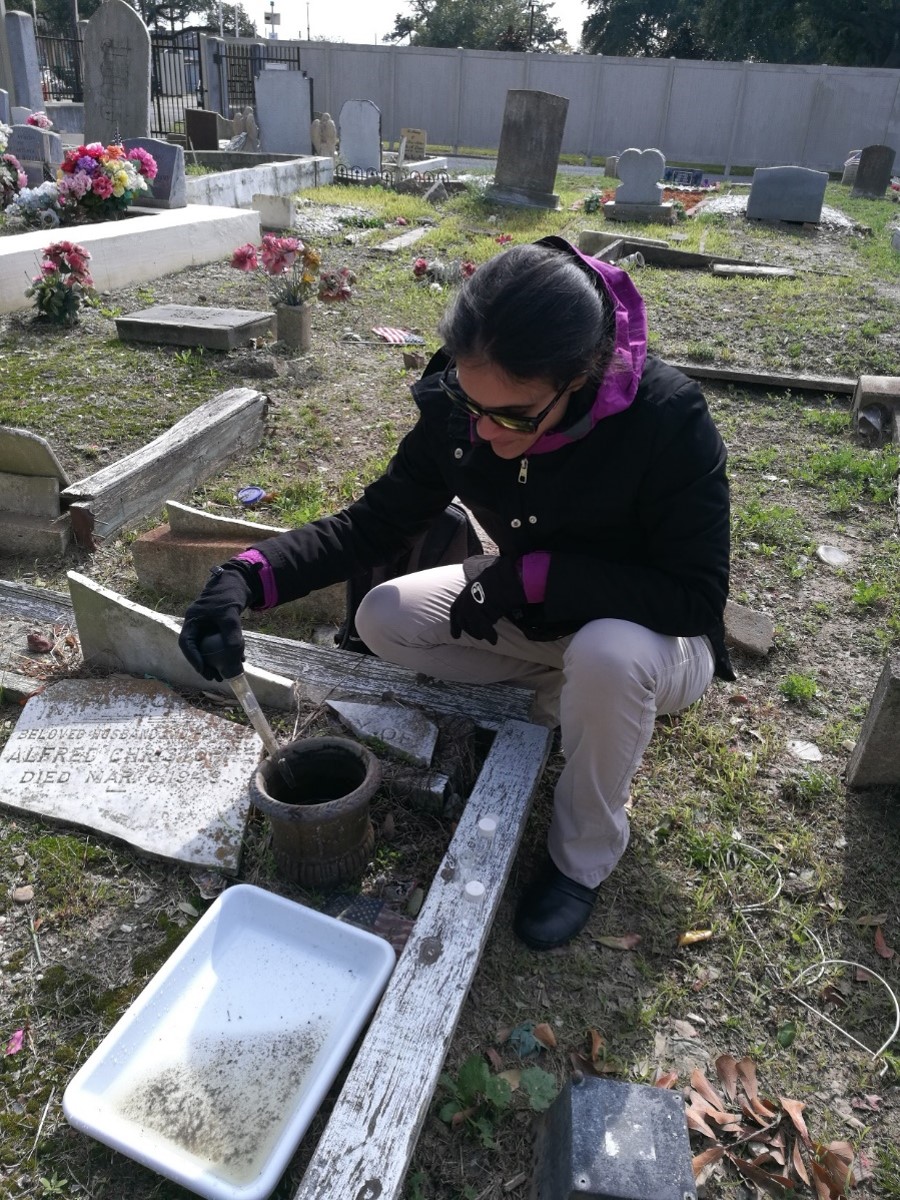What’s for dinner: better understanding the feeding habits of mosquito larvae
May 08, 2023

Department of Environmental Sciences Assistant Professor Rebeca de Jesus Crespo takes a sample in a New Orleans cemetery
– Photo Credit: Rebeca de Jesus Crespo
BATON ROUGE - Here in Louisiana, once early summer hits, it can seem like mosquitoes are everywhere.
But the truth is, the mosquito, like any other creature, flourishes under certain conditions and struggles under others. This also holds true for their larvae, whose success can be influenced by the food they eat. Assistant Professor of Environmental Sciences Rebeca de Jesús Crespo studies mosquito ecology, and her latest publication, out in the Journal of Medical Entomology, takes a deeper dive into determining under which environmental conditions determine the food consumed by baby mosquitoes—another step in her larger project of better understanding in urban environments.
de Jesús Crespo and her team conducted their research in the cemeteries of New Orleans, gathering samples of mosquito larvae out of the standing water present in many cemetery vases. The conditions of the vases vary; some cemeteries have tree canopy and some are in full sun, and the study wanted to see if differences in these environments affected the type of food available for mosquito larvae and their diets.
“Larvae nutrition influences the health, size and longevity of adult mosquitoes, all which are factors that can affect their effectiveness at transmitting disease,” said de Jesús Crespo.
De Jesús Crespo, along with Masters student Rachel Rogers focused on food sources available to the larvae, which vary according to the environmental conditions the individual vase. Mosquito wrigglers eat almost constantly until they exit the larval stage, dining on their immediate surrounding organic detritus—which can be anything from algae to leaf litter--and micro-organisms. The study predicted that a vase in full sunlight will have more algae for the larvae to feast on; while vases under the canopy of a tree present a banquet dominated by leaf litter.
Department of Oceanography & Coastal Sciences Associate Professor Mike Polito conducted a stable isotope analysis on the larvae and the vase’s water to determine if tree canopy was indeed a driving force in the type of food available to mosquito larvae. His analysis confirmed this, larvae in sunlight containers have more algae available and are consuming a greater proportion of algae.
This could have important implications for the spread of mosquito borne illnesses, as different species of algae may affect the larvae in different ways. Certain algae can be a great source of fatty acids, and promote growth, while others can be toxic, de Jesús Crespo said.
Healthier mosquito larvae may grow larger and live longer, but their own immune systems may also be better equipped to fight off diseases, meaning they are less likely to transmit them. Alternately, a smaller, less healthy mosquito may be more susceptible to disease but also less likely to live long enough to transmit it very well. “We believe that the proportion of certain types of food such as algae can influence these dynamics and should be studied more,” de Jesús Crespo continued.
A better understanding of these food dynamics can have big implications for urban planning, she says. Urban greening initiatives, for example, can impact mosquito vector populations in different ways, and their work seeks to understand these dynamics better. Mosquitoes are known vectors of many different diseases, and knowing more about how they live can help planners prevent conditions that contribute to the spread of disease.
“My hypothesis is that vegetated areas can have an influence in mitigating an epidemic of vector borne disease or exacerbating it depending on the types of vectors that are involved,” she said. "Vegetation drives the food available to mosquito larvae, and this study helped us understand how."